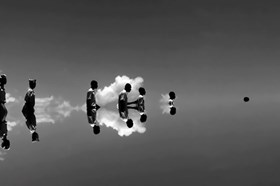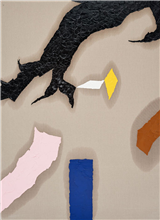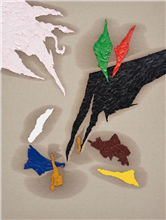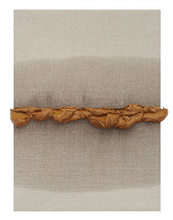cape reviews
Kant’s Blom and Wallpaper
Zander Blom at STEVENSON in Cape Town
By M Blackman28 August - 04 October. 0 Comment(s)
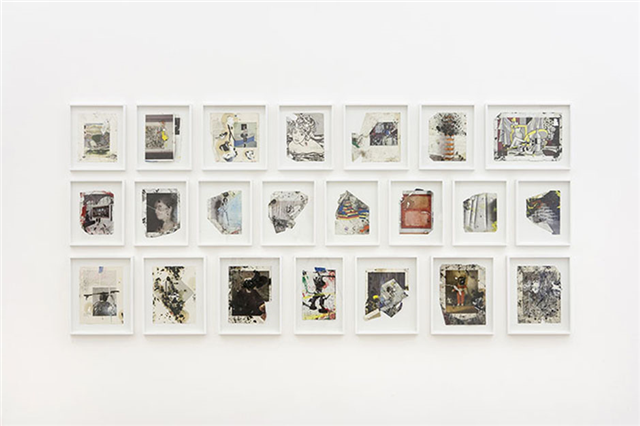
Zander Blom
Modern Painting 3 (Floor Pieces),
2014.
Mixed media
Dimensions variable.
I have written on several occasions of my concerns about the current swathe of abstract painting that has filled our galleries in the last three years. There are at this particular moment three (four if you count the residency of Jan-Henri Booyens at the AVA) such exhibitions being held: Zander Blom, Kerry Chaloner and Chris van Eeden/Emma Nourse. And I – and here I really do speak for myself – am confused.
art events calendar
VIEW FULL CALENDARbuy art prints
edition of 60: R7,500.00
About Editions for ArtThrob
Outstanding prints by top South African artists. Your chance to purchase SA art at affordable prices.
FIND OUT MORE Editions for artthrobThere is a time when critics must accept that just because something is not to their liking – or even not within their understanding - that there could very well be value in work if there is sustained critical approval of it coming from other notable quarters. One of the major factors in addressing the work of Zander Blom is that he is represented by Stevenson. Although there are many critical-Nimrods out there who stalk the internet for any opportunity to take a pot shot at the gallery, the fact remains that Stevenson’s role as leading contemporary art experts and groundbreakers is hard to deny. To ignore their status and acumen would more often than not be an act of churlishness.
This is not to say that they haven’t made mistakes. Certainly they have – and I think they would freely admit to this. But in the case of Blom they are certainly convinced of his work, in a way that I remain uncertain of. In saying this however, like many people out there, I do think Blom’s paintings are beautiful. In fact this is my principle concern.
In attempting to understand the concept of beauty, many art theorists have quoted Immanuel Kant’s definition, and have used it as a mantra for understanding what art is. But Kant had two notions of beauty. One he called ‘free beauty’ the other ‘dependent’. An object of ‘free beauty’, he suggested, is one that is universally considered beautiful because it is free of purpose. Although this kind of object seems to have a concept behind it, Kant argued, it does not. He went on to give examples of this: the rose and a certain wallpaper that he had in his own meager house. This beauty has no purpose. A rose is not beautiful because it attracts bees, we just say it is beautiful because, well, it just is!
However, Kant argued, this was not the beauty of art. The beauty of art has a distinct purpose to it: it is ‘dependent’ on something. It has a concept behind it, which can be explained. If art did not, it should be pointed out, then art criticism would be the greatest waste of time ever embarked upon. Artworks would simply be beautiful and there would be no purpose or reason behind engaging with them critically. Alberti, Vasari, Ruskin, Clark, Sontag, Hughes, Lippard, Krauss, Enwezor, Collings would have and are spending their lives in a performance of pure futility.
And it is here where I question Blom’s work. What is the idea behind it and what is its beauty dependent on? Most abstract expressionists from the New York school would have argued that they were not simply putting paint on canvas like petals on a flower but rather, as Arthur C Danto put it, that their paint ‘embodied meaning’. Certainly the likes of Barnet Newman believed himself to be doing something identical to what Michelangelo did. Again Danto’s writing is apt: ‘Abstract painting is not without content. Rather, it enables the presentation of content with pictorial limits. That is why, from the beginning, abstraction was believed by its inventors to be invested with a spiritual reality.’
This reality I have no doubt of. On occasion I have (although I am far from a spiritual person) felt this spirituality in abstract works. But in feeling this I have always sensed that I am feeling something explained from the past. That perhaps there is universal content to that emotion but that its forms and methods are transported to me through time and culture. I cannot read works produced in New York in 1951 as something that represents the South Africa of 2014 – although part of the joy of art is to realise the cross-overs and commonalties. In short, abstract expressionism’s time, when it represented the deeper meanings of the human condition, is over – it was of its time or what linguists refer to as synchronic. Its current use, if it has a use, must surely address a new set of concerns.
So where does this leave me with regard to Zander Blom’s work. According to Blom, Matisse heavily influences his work, and to be sure, the minute I walked into the gallery I had Matisse in mind. But why now, why in 2014, are we going back to Matisse’s late collage period and rendering it in abstract expressionist form? How is Blom’s appropriation of these methods of representation communicating what it is to be a person in the early 21st century and a person living in South Africa? How is all that underpinned late modernism relevant to who and where we are now?
Perhaps Matisse might offer us some direction. As Robert Hughes pointed out, Matisse, despite having lived through and amongst some of the most fraught history of the last two hundred years, ‘never made a didactic painting or signed a manifesto and there is scarcely one reference to a political event – let alone an expression of political opinion – to be found anywhere in his writings.’
This seems true of Blom. Certainly all of his paintings with their numbered titles are not meant as a political statement or even a social one. It is perhaps easy to see that much of the abstract work coming out of many painters today, particularly white males, may be just that, a refusal to address the current and historical state of this country. What can a white male say and contribute when faced with the political reality of South Africa? Perhaps the Rhodes academic, Samantha Vice, is right when she argued that in that a certain quietism should indeed be required and felt by white people in South Africa.
Blom does seem to suggest in his artist’s statement that the art world is full of nonsensical utterances and political hypocrisies and that he will not be part of it. Blom intimates that his work is essentially addressing his response to art history and its relationship to his own emotions. But is this not true of most people’s art? And what is more, why is the late modernist approach the best method for doing this? Abstraction, as I have argued, was a response to and dependent on a specific time and place, a response to a world at war, dependent on a world of machinery, a world that demanded freedom and a world trying to find a new path after the decline of Christianity.
You might say, fair enough, so is Blom’s. But Blom’s response is a different one in that it contains the conservatism of holding onto the past values (i.e. those of abstraction) and this is precisely what modernism and abstraction tried to deny. There are, after all, some major differences between Matisse and Blom’s response to their environment. Where Matisse was denying the current state of affairs; was revolutionary in his approach; was forward thinking and was engaged with the time and place even if he denied its politics – Blom and, it must be said, many others painting today are not. They are merely dependent on little more than an art historical period. This contemporary group of artists are conservatives who look backwards, they are not inventors but assimilators, not spiritualists but materialists.
We live in an age of uncertainty, one that perhaps demands a certain refusal to be drawn into tireless mendacious public utterances. However, as Tony Judt said of contemporary writers: ‘In “Politics and the English Language,” Orwell castigated contemporaries for using language to mystify rather than inform. His critique was directed at bad faith: people wrote poorly because they were trying to say something unclear or else deliberately prevaricating. Our problem, it seems to me, is different. Shoddy prose today bespeaks intellectual insecurity: we speak and write badly because we don’t feel confident in what we think and are reluctant to assert it unambiguously (“It’s only my opinion…”). Rather than suffering from the onset of “newspeak,” we risk the rise of “nospeak.”’
One feels that this is perhaps true too of painting. Although not necessarily ‘bad’, in fact with Blom is it impossible to say whether he is a good or bad painter (a good applicationist might be a better term) but there is a sense of nospeak about his work. Perhaps this is an adequate response to the contemporary position of uncertainty; I don’t speak out so that I can exist! The age of the fear of saying anything that could be taken to mean something politically incorrect and being roasted on the fires of social media is certainly upon us. But if Blom’s art is this refusal then why is this statement so clouded in the joy of primary colours and why does it go so well in north facing Clifton apartments? That is, is it saying anything more than Kant’s flower and wallpaper? And is it dependent on anything other than its surface?





